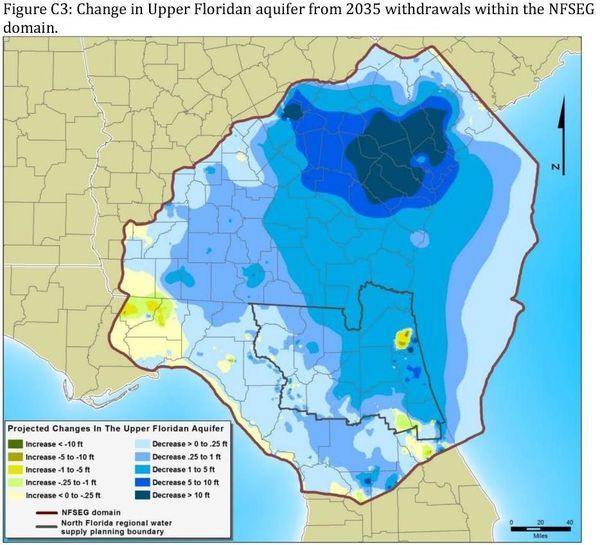You can help the Suwannee River Water Management District Board uphold the public interest and reject Nestlé’s water withdrawal permit application.
Even SRWMD’s legal counsel only recommends approving the Seven Springs permit “under protest.” The DOAH judge’s Order is actually only a RECOMMENDATION, and the District filed eighteen pages of exceptions to that Order. The judge disallowed most of those exceptions, but SRWMD is still holding open the possibility of appeal with that “under protest”.
The Judge’s Order dances around the basic question: is putting water in plastic bottles after taking it from the Floridan Aquifer next to a depleted river and springs, all for profit of a Swiss company, in the public interest? Florida law and the judge attempt to narrow what can be considered down what can be considered for the public interest to what is in Florida rules or a handbook, even though none of those adequately address the real issues. The plain fact is that a contract to sell water does not determine any public interst in cleaning up plastic bottles from our springs and rivers, nor does it determine any public interest in lower springs and rivers, with bad effects on wildlife, public use of those waters, and eventually on drinking water.
The SRWMD board can deny this permit because it is not in the public interest. You can help them do so.
It almost looks like the SRWMD counsel is asking people to come protest, since he repeatedly mentions that Our Santa Fe River (OSFR) filed legal motions and both Merrillee Malwitz-Jipson and Michael Roth spoke in the legal hearing. Disclosure: WWALS has provided some financial support for OSFR’s legal actions in this matter.
If you’re going to attend this Special Meeting in person, get there early to get a spot. To attend online, be sure to sign up for both the webinar and cal in for audio. If you want to comment, you must also sign up for that separately. Don’t wait for the second day: if that happens at all, there will be no public comment.
So come early on the first day, in person or online, Tuesday, February 23, 2021.
The entire SRWMD Special Meeting Board packet is on the WWALS website: https://www.wwals.net/pictures/2021-02-23–srwmd-nestle-special-meeting-packet/
Here is the agenda, with how to attend online: Continue reading

![[Agenda, Board, No Permit]](https://www.wwals.net/pictures/2021-02-23--srwmd-nestle-special-meeting-packet/many.jpg)
![[Lifted, Chart, Markers, Map]](https://www.wwals.net/pictures/2021-01-12--wq/many.jpg)
![[Dateline, Op-ed]](https://www.wwals.net/pictures/2020-12-23--vdt-okefenokee-suwrk/manyrot.jpg)
![[Mine site, Okefenokee Swamp, TIAA land, TPM land]](https://www.wwals.net/pictures/2020-11-30--wwals-to-ga-gov-tpm-okefenokee/many.jpg)
![[Map and Proposal]](https://www.wwals.net/pictures/2016-11-14--djprice-nfrwsp-recharge/many.jpg)
![[Great Blue Heron, Suwannee River, Okefenokee Swamp, TPM mine site]](https://www.wwals.net/pictures/2020-11-17--gwc-dd/many.jpg)
![[TPM mine site with ONWR on left]](https://www.wwals.net/pictures/2020-11-06--tpm-drone/tpm-site-onwr-left.jpg)
![[Great Blue Heron flying, Suwannee River, Okefenokee Swamp, 2019-12-07]](https://www.wwals.net/pictures/2020-11-17--gwc-dd/2019-12-07--jsq-gbh-suwannee-river-okefenokee-with-boaters.jpg)
![[2019-04-03 White Sulfur Spring Flowing]](https://www.wwals.net/pictures/2016-12-12--djprice-nfrwsp/2019-04-03--white-sulfur-spring-flowing.jpg)

![[Page 2]](https://www.wwals.net/pictures/2020-06-19--tpm-ga-dnr-surface-mining-application/SAS-2018-00554-June-19-Application-Update-Letter-0002.jpg)
![[Tannin Times, WWALS monthly newsletter]](https://www.wwals.net/pictures/2020-11-01--tannin-times/tannin-times.jpg)